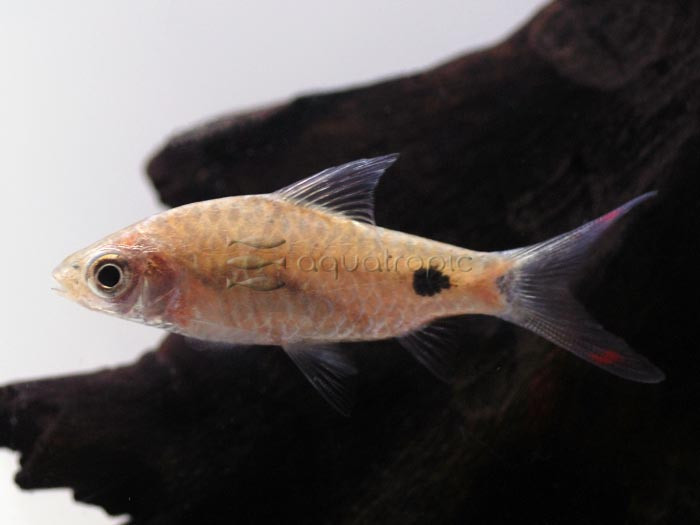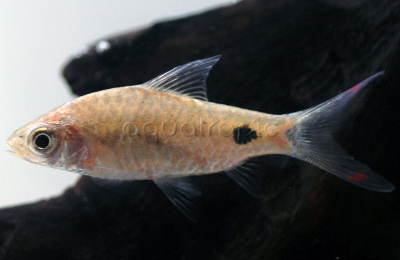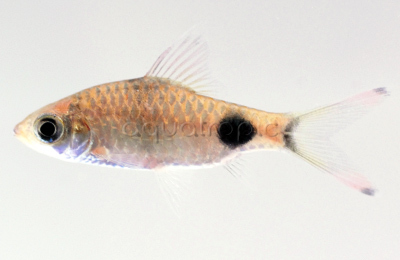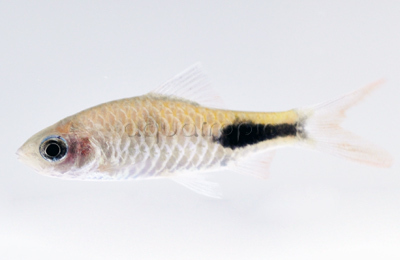Big, Beautiful Dawkinsia Barbs

In 2012, a major morphological study appeared which examined the evolutionary relationship of a large group of barbs from South Asia that had at the time been lumped together into a single cumbersome genus, Puntius. From this research, a number of new names would emerge for fishes familiar to aquarists.
The genus Pethia (from the local Sinhalese word for these small cyprinids) was created for a diverse group of small barbs, including the Rosy, Golden, and Black-Ruby, among many other common aquarium fishes. Systomus was a name resurrected for a group of large, silvery species, few of which are known to aquarists. The Melon Barb and its close relatives briefly became known as Dravidia, only to be renamed as Haludaria the following year due to that name being already preoccupied by a type of fly. Haludar was the name of a young Indian artist who illustrated an important work on the region’s fishes in 1797.
And lastly, a group of nine species from Southern India and Sri Lanka was combined into Dawkinsia. This name honors the influential biologist Sir Richard Dawkins, author of seminal works like The Selfish Gene and The Extended Phenotype, along with several controversial books dealing with religion and atheism.
Dawkinsia shares a few important characteristics, though these aren’t terribly obvious at first glance. Their size is moderate with respect to the other barbs mentioned, averaging 80-120mm, and the juveniles have a distinctive pattern of three vertical bars, which is maintained into adulthood in several species but lost in others. The last dorsal fin ray is smooth (versus serrated in Pethia), the rostral barbels are absent (present in Haludaria & Systomus), and there are a relatively low number of lateral line scales, 18-22 (compared to 22-28 in Puntius).
Thanks to their relatively large size, attractive patterning, and general heartiness, almost every member of this group has found its way into the aquarium trade at one time or another. Of course, some are more readily available than others, and many are easily confused and liable to be misidentified.
Aquarium care is relatively straightforward, with the caveat that these energetic and robustly proportioned fishes need room to stretch their fins. Ideally, a large shoal will require aquariums measuring in at 90+ gallons. And this is definitely a group that should be kept in numbers, as this not only reduces any stress within the shoal, but also allows the males to color up to their fullest while displaying to females (which, in typical barb fashion, are less vibrant). So let’s meet some of these species, shall we?

Filamentosus Barb (Dawkinsia filamentosus)
This is one of the “teardrop” species, which lose the juvenile coloration in adulthood and instead have a single black spot near the caudal peduncle. The Filamentosus Barb is so named for the wispy extensions of the dorsal fin that develop in breeding males. This coincides with the development of numerous tubercles on the snout and an overall increase in coloration, with the back turning an interesting golden hue. This is reportedly a widespread species in the southern tip of India, and its true range is now thought to encompass almost the entirety of peninsular India. It is most often encountered in coastal floodplains, with the type locality being a brackish environment. Here, it can co-occur with others from this genus (e.g. D. tambraparniei), but the two are able to co-exist by utilizing slightly different habitats and food sources. Whereas D. filamentosus makes use of the flowing waters along riverbanks and feeds heavily on algae, the D. tambraparniei from these waters favor stagnant pools and mostly consume benthic invertebrates. The two are thought to hybridize on occasion, owing to intermediate specimens having been found. D. filamentosus is a common species, and populations have been accidentally introduced outside its native range (such as around Singapore) through the aquarium trade.

Mascara Barb (Dawkinsia assimilis)
The Mascara Barb is unique within this genus for having a subterminal mouth (i.e. pointing downward), though it seems to be largely unknown what this is adapted for. The only other species that shares this trait is D. srilankensis, which is one of the only Dawkinsia that hasn’t been collected for the aquarium trade. The two look little alike, though, with the male coloration of D. assimilis being one of the most instantly recognizable in the genus, with a splash of red on the snout and above the eye (the “mascara”) that descends into a swooping arc along the sides. The dorsal fin develops a deep red, but, unlike many of the other Dawkinsia, this species doesn’t develop filamentous extensions to the dorsal fin. You’ll find D. assimilis in a relatively restricted portion of Southwestern India, where populations are known from a wide variety of lotic habitats, including areas with high flow and a cobble substrate and those with low flow and muddy bottoms. However, it is only known from a total of four river systems, leading the IUCN to list it as being Vulnerable to extinction. Thankfully, aquarium specimens are now predominantly captive-bred.

Tambraparni (Dawkinsia tambraparniei)
While some Dawkinsia are common and widespread, others, like D. tambraparniei, are far less common. This species is named for the Thamirabarani River in Southern India and it is the only known habitat for this fish. It occurs in the upper reaches of this river basin, which amounts to little more than 100 square kilometers of inhabitable streams for this fish. The population is naturally small and has now been listed by the IUCN as being Endangered. Particular threats include the mining of sand from its streams, along with the usual risks of pollution and unmanaged aquarium collection. Wild specimens are now becoming uncommon in aquarium exports as this species joins others in being commercially produced. Males of D. tambraparniei develop filamentous extensions to the dorsal fin, but otherwise look little like the Filamentosus Barb. The juvenile patterning remains into adulthood and the caudal fin is a solid orange, lacking black tips. It was originally described as a subspecies of the Arulius Barb (D. arulius), but it is now regarded as a valid species. D. arulius males are told apart in lacking filamentous dorsal fin extensions.

Rohan’s Teardrop Barb (Dawkinsia rohani)
The hill streams of the Kanyakumari District in Southern India are the only known home of D. rohani, and this limited range has led the IUCN to list this species as Vulnerable to extinction. This is the most recently described member of the genus, only having been named in 2010, and it would be easy to mistake it for its widespread lowland cousin, D. filamentosus. The two both have similar male color patterns and filamentous extensions of the dorsal fin, but Rohan’s Teardrop Barb differs in lacking the black caudal fin tips of the Filamentosus Barb. Though it might be rare in nature, this is now one of the more frequently seen Dawkinsia.